Transitioning from LVN to BN: Professional Concepts and Patient Care
VerifiedAdded on 2023/06/15
|7
|1758
|99
Essay
AI Summary
This essay explores the transition process for Licensed Vocational Nurses (LVNs) upgrading their credentials to Bachelor of Nursing (BN) degrees, focusing on the professional socialization and challenges encountered during this role transition. It highlights the differences in responsibilities, skills, and knowledge acquisition between LVNs and BNs, emphasizing the importance of critical thinking, communication skills, and continuous professional development. The essay also discusses the application of Kurt Lewin's Change Theory to understand the stages of transition, from unfreezing to refreezing, and the educational changes required to meet the BSN program's coursework and clinical requirements. Ultimately, the goal is to equip LVNs with the necessary skills and knowledge to improve patient care and advance their nursing careers.
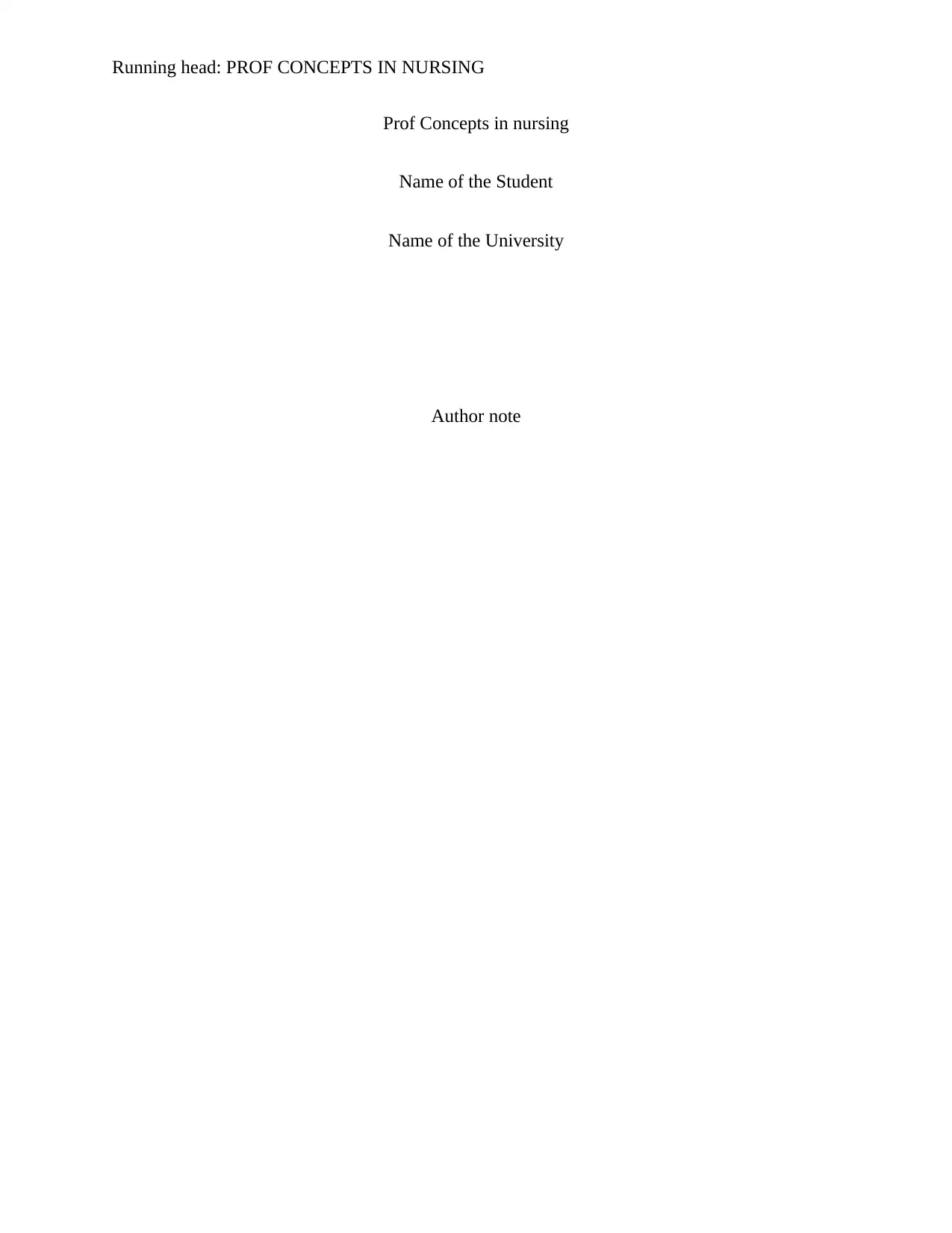
Running head: PROF CONCEPTS IN NURSING
Prof Concepts in nursing
Name of the Student
Name of the University
Author note
Prof Concepts in nursing
Name of the Student
Name of the University
Author note
Paraphrase This Document
Need a fresh take? Get an instant paraphrase of this document with our AI Paraphraser
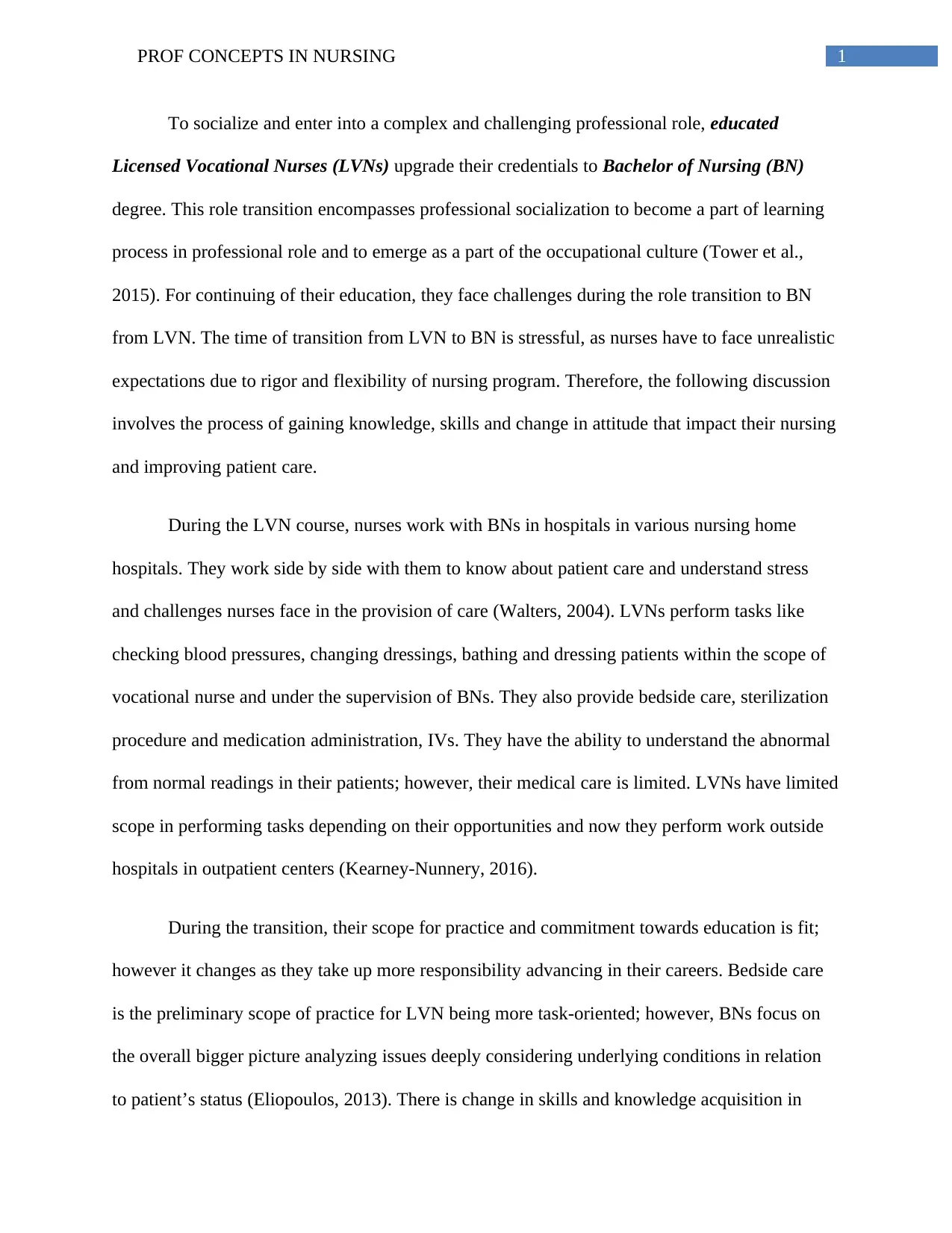
1PROF CONCEPTS IN NURSING
To socialize and enter into a complex and challenging professional role, educated
Licensed Vocational Nurses (LVNs) upgrade their credentials to Bachelor of Nursing (BN)
degree. This role transition encompasses professional socialization to become a part of learning
process in professional role and to emerge as a part of the occupational culture (Tower et al.,
2015). For continuing of their education, they face challenges during the role transition to BN
from LVN. The time of transition from LVN to BN is stressful, as nurses have to face unrealistic
expectations due to rigor and flexibility of nursing program. Therefore, the following discussion
involves the process of gaining knowledge, skills and change in attitude that impact their nursing
and improving patient care.
During the LVN course, nurses work with BNs in hospitals in various nursing home
hospitals. They work side by side with them to know about patient care and understand stress
and challenges nurses face in the provision of care (Walters, 2004). LVNs perform tasks like
checking blood pressures, changing dressings, bathing and dressing patients within the scope of
vocational nurse and under the supervision of BNs. They also provide bedside care, sterilization
procedure and medication administration, IVs. They have the ability to understand the abnormal
from normal readings in their patients; however, their medical care is limited. LVNs have limited
scope in performing tasks depending on their opportunities and now they perform work outside
hospitals in outpatient centers (Kearney-Nunnery, 2016).
During the transition, their scope for practice and commitment towards education is fit;
however it changes as they take up more responsibility advancing in their careers. Bedside care
is the preliminary scope of practice for LVN being more task-oriented; however, BNs focus on
the overall bigger picture analyzing issues deeply considering underlying conditions in relation
to patient’s status (Eliopoulos, 2013). There is change in skills and knowledge acquisition in
To socialize and enter into a complex and challenging professional role, educated
Licensed Vocational Nurses (LVNs) upgrade their credentials to Bachelor of Nursing (BN)
degree. This role transition encompasses professional socialization to become a part of learning
process in professional role and to emerge as a part of the occupational culture (Tower et al.,
2015). For continuing of their education, they face challenges during the role transition to BN
from LVN. The time of transition from LVN to BN is stressful, as nurses have to face unrealistic
expectations due to rigor and flexibility of nursing program. Therefore, the following discussion
involves the process of gaining knowledge, skills and change in attitude that impact their nursing
and improving patient care.
During the LVN course, nurses work with BNs in hospitals in various nursing home
hospitals. They work side by side with them to know about patient care and understand stress
and challenges nurses face in the provision of care (Walters, 2004). LVNs perform tasks like
checking blood pressures, changing dressings, bathing and dressing patients within the scope of
vocational nurse and under the supervision of BNs. They also provide bedside care, sterilization
procedure and medication administration, IVs. They have the ability to understand the abnormal
from normal readings in their patients; however, their medical care is limited. LVNs have limited
scope in performing tasks depending on their opportunities and now they perform work outside
hospitals in outpatient centers (Kearney-Nunnery, 2016).
During the transition, their scope for practice and commitment towards education is fit;
however it changes as they take up more responsibility advancing in their careers. Bedside care
is the preliminary scope of practice for LVN being more task-oriented; however, BNs focus on
the overall bigger picture analyzing issues deeply considering underlying conditions in relation
to patient’s status (Eliopoulos, 2013). There is change in skills and knowledge acquisition in
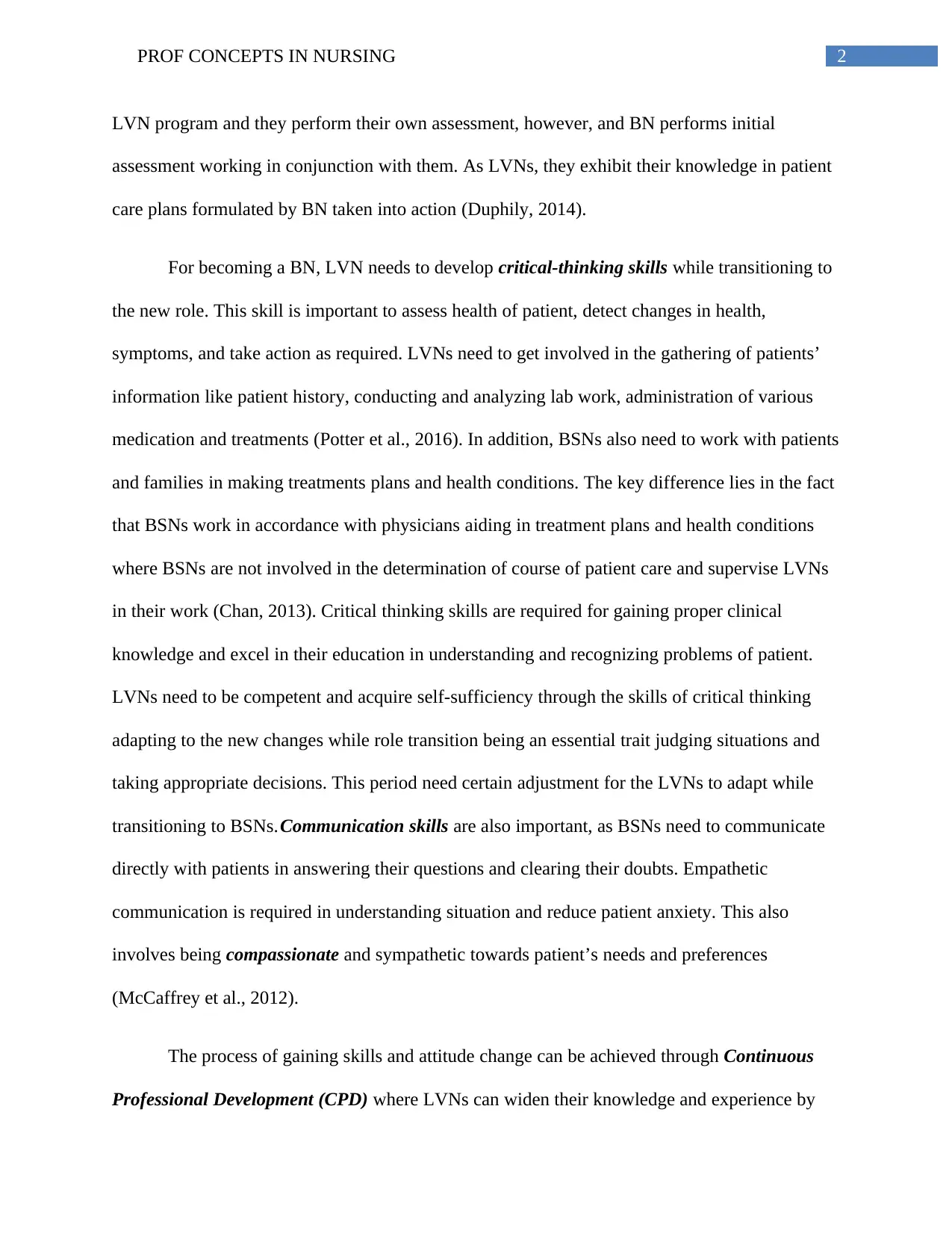
2PROF CONCEPTS IN NURSING
LVN program and they perform their own assessment, however, and BN performs initial
assessment working in conjunction with them. As LVNs, they exhibit their knowledge in patient
care plans formulated by BN taken into action (Duphily, 2014).
For becoming a BN, LVN needs to develop critical-thinking skills while transitioning to
the new role. This skill is important to assess health of patient, detect changes in health,
symptoms, and take action as required. LVNs need to get involved in the gathering of patients’
information like patient history, conducting and analyzing lab work, administration of various
medication and treatments (Potter et al., 2016). In addition, BSNs also need to work with patients
and families in making treatments plans and health conditions. The key difference lies in the fact
that BSNs work in accordance with physicians aiding in treatment plans and health conditions
where BSNs are not involved in the determination of course of patient care and supervise LVNs
in their work (Chan, 2013). Critical thinking skills are required for gaining proper clinical
knowledge and excel in their education in understanding and recognizing problems of patient.
LVNs need to be competent and acquire self-sufficiency through the skills of critical thinking
adapting to the new changes while role transition being an essential trait judging situations and
taking appropriate decisions. This period need certain adjustment for the LVNs to adapt while
transitioning to BSNs.Communication skills are also important, as BSNs need to communicate
directly with patients in answering their questions and clearing their doubts. Empathetic
communication is required in understanding situation and reduce patient anxiety. This also
involves being compassionate and sympathetic towards patient’s needs and preferences
(McCaffrey et al., 2012).
The process of gaining skills and attitude change can be achieved through Continuous
Professional Development (CPD) where LVNs can widen their knowledge and experience by
LVN program and they perform their own assessment, however, and BN performs initial
assessment working in conjunction with them. As LVNs, they exhibit their knowledge in patient
care plans formulated by BN taken into action (Duphily, 2014).
For becoming a BN, LVN needs to develop critical-thinking skills while transitioning to
the new role. This skill is important to assess health of patient, detect changes in health,
symptoms, and take action as required. LVNs need to get involved in the gathering of patients’
information like patient history, conducting and analyzing lab work, administration of various
medication and treatments (Potter et al., 2016). In addition, BSNs also need to work with patients
and families in making treatments plans and health conditions. The key difference lies in the fact
that BSNs work in accordance with physicians aiding in treatment plans and health conditions
where BSNs are not involved in the determination of course of patient care and supervise LVNs
in their work (Chan, 2013). Critical thinking skills are required for gaining proper clinical
knowledge and excel in their education in understanding and recognizing problems of patient.
LVNs need to be competent and acquire self-sufficiency through the skills of critical thinking
adapting to the new changes while role transition being an essential trait judging situations and
taking appropriate decisions. This period need certain adjustment for the LVNs to adapt while
transitioning to BSNs.Communication skills are also important, as BSNs need to communicate
directly with patients in answering their questions and clearing their doubts. Empathetic
communication is required in understanding situation and reduce patient anxiety. This also
involves being compassionate and sympathetic towards patient’s needs and preferences
(McCaffrey et al., 2012).
The process of gaining skills and attitude change can be achieved through Continuous
Professional Development (CPD) where LVNs can widen their knowledge and experience by
⊘ This is a preview!⊘
Do you want full access?
Subscribe today to unlock all pages.

Trusted by 1+ million students worldwide
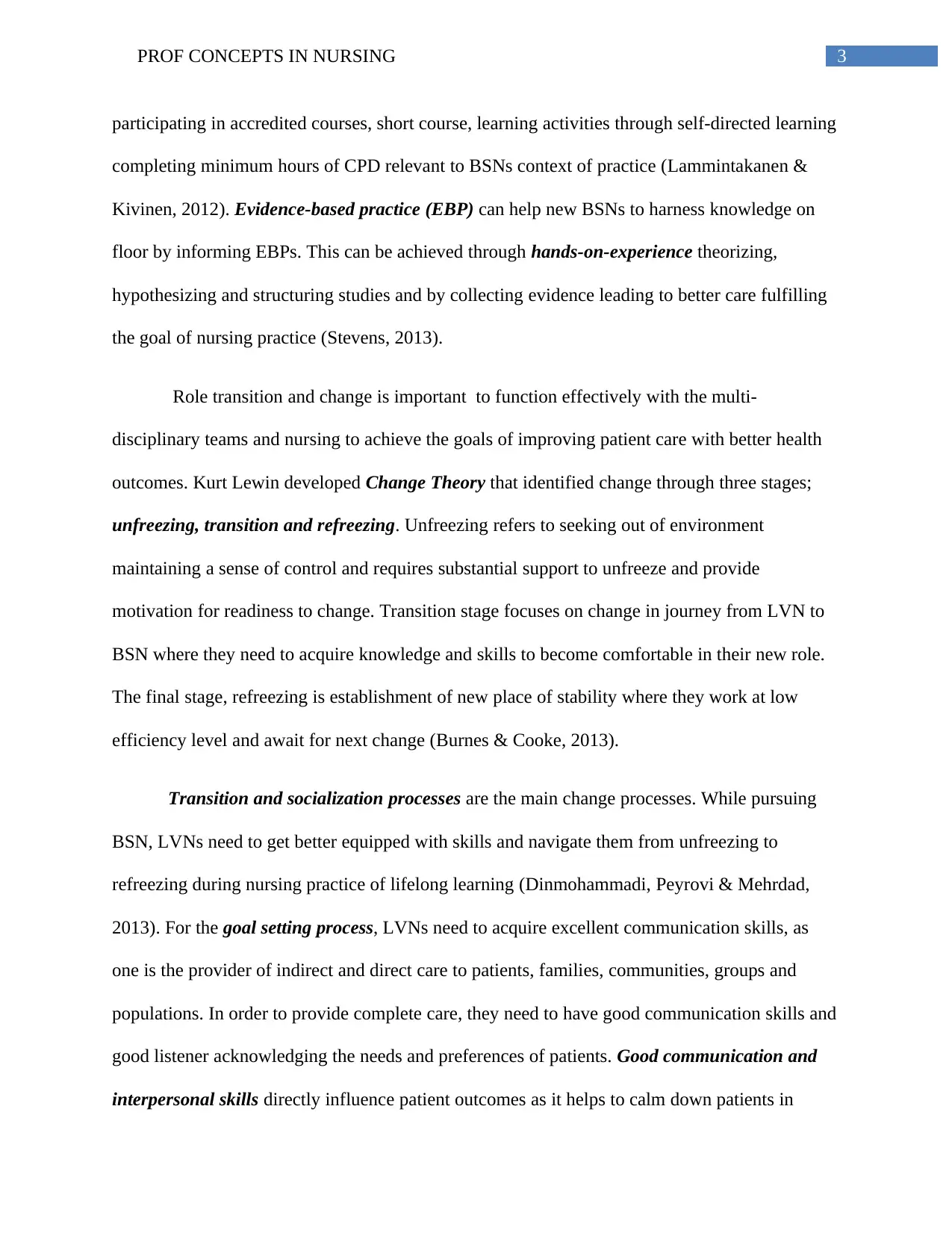
3PROF CONCEPTS IN NURSING
participating in accredited courses, short course, learning activities through self-directed learning
completing minimum hours of CPD relevant to BSNs context of practice (Lammintakanen &
Kivinen, 2012). Evidence-based practice (EBP) can help new BSNs to harness knowledge on
floor by informing EBPs. This can be achieved through hands-on-experience theorizing,
hypothesizing and structuring studies and by collecting evidence leading to better care fulfilling
the goal of nursing practice (Stevens, 2013).
Role transition and change is important to function effectively with the multi-
disciplinary teams and nursing to achieve the goals of improving patient care with better health
outcomes. Kurt Lewin developed Change Theory that identified change through three stages;
unfreezing, transition and refreezing. Unfreezing refers to seeking out of environment
maintaining a sense of control and requires substantial support to unfreeze and provide
motivation for readiness to change. Transition stage focuses on change in journey from LVN to
BSN where they need to acquire knowledge and skills to become comfortable in their new role.
The final stage, refreezing is establishment of new place of stability where they work at low
efficiency level and await for next change (Burnes & Cooke, 2013).
Transition and socialization processes are the main change processes. While pursuing
BSN, LVNs need to get better equipped with skills and navigate them from unfreezing to
refreezing during nursing practice of lifelong learning (Dinmohammadi, Peyrovi & Mehrdad,
2013). For the goal setting process, LVNs need to acquire excellent communication skills, as
one is the provider of indirect and direct care to patients, families, communities, groups and
populations. In order to provide complete care, they need to have good communication skills and
good listener acknowledging the needs and preferences of patients. Good communication and
interpersonal skills directly influence patient outcomes as it helps to calm down patients in
participating in accredited courses, short course, learning activities through self-directed learning
completing minimum hours of CPD relevant to BSNs context of practice (Lammintakanen &
Kivinen, 2012). Evidence-based practice (EBP) can help new BSNs to harness knowledge on
floor by informing EBPs. This can be achieved through hands-on-experience theorizing,
hypothesizing and structuring studies and by collecting evidence leading to better care fulfilling
the goal of nursing practice (Stevens, 2013).
Role transition and change is important to function effectively with the multi-
disciplinary teams and nursing to achieve the goals of improving patient care with better health
outcomes. Kurt Lewin developed Change Theory that identified change through three stages;
unfreezing, transition and refreezing. Unfreezing refers to seeking out of environment
maintaining a sense of control and requires substantial support to unfreeze and provide
motivation for readiness to change. Transition stage focuses on change in journey from LVN to
BSN where they need to acquire knowledge and skills to become comfortable in their new role.
The final stage, refreezing is establishment of new place of stability where they work at low
efficiency level and await for next change (Burnes & Cooke, 2013).
Transition and socialization processes are the main change processes. While pursuing
BSN, LVNs need to get better equipped with skills and navigate them from unfreezing to
refreezing during nursing practice of lifelong learning (Dinmohammadi, Peyrovi & Mehrdad,
2013). For the goal setting process, LVNs need to acquire excellent communication skills, as
one is the provider of indirect and direct care to patients, families, communities, groups and
populations. In order to provide complete care, they need to have good communication skills and
good listener acknowledging the needs and preferences of patients. Good communication and
interpersonal skills directly influence patient outcomes as it helps to calm down patients in
Paraphrase This Document
Need a fresh take? Get an instant paraphrase of this document with our AI Paraphraser
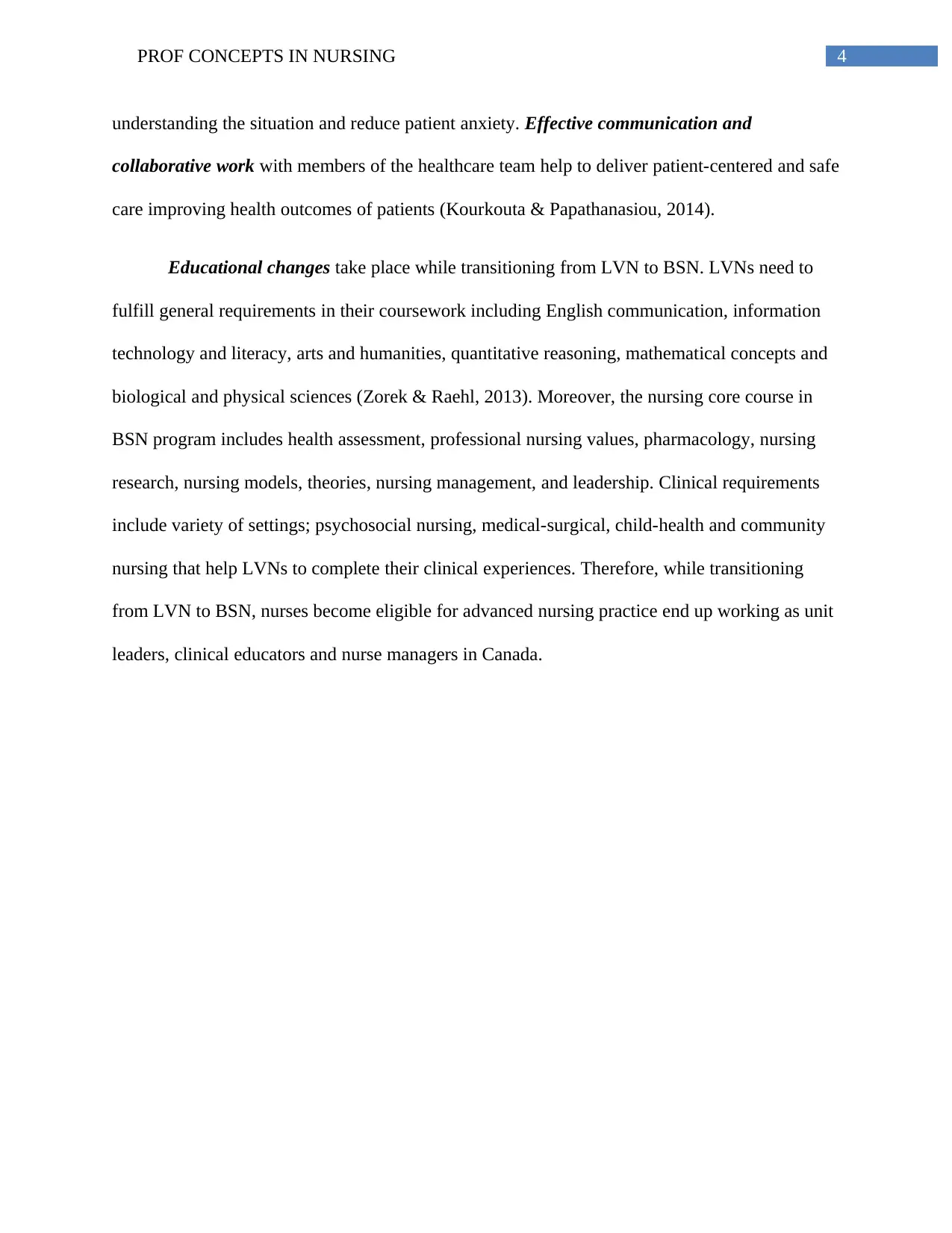
4PROF CONCEPTS IN NURSING
understanding the situation and reduce patient anxiety. Effective communication and
collaborative work with members of the healthcare team help to deliver patient-centered and safe
care improving health outcomes of patients (Kourkouta & Papathanasiou, 2014).
Educational changes take place while transitioning from LVN to BSN. LVNs need to
fulfill general requirements in their coursework including English communication, information
technology and literacy, arts and humanities, quantitative reasoning, mathematical concepts and
biological and physical sciences (Zorek & Raehl, 2013). Moreover, the nursing core course in
BSN program includes health assessment, professional nursing values, pharmacology, nursing
research, nursing models, theories, nursing management, and leadership. Clinical requirements
include variety of settings; psychosocial nursing, medical-surgical, child-health and community
nursing that help LVNs to complete their clinical experiences. Therefore, while transitioning
from LVN to BSN, nurses become eligible for advanced nursing practice end up working as unit
leaders, clinical educators and nurse managers in Canada.
understanding the situation and reduce patient anxiety. Effective communication and
collaborative work with members of the healthcare team help to deliver patient-centered and safe
care improving health outcomes of patients (Kourkouta & Papathanasiou, 2014).
Educational changes take place while transitioning from LVN to BSN. LVNs need to
fulfill general requirements in their coursework including English communication, information
technology and literacy, arts and humanities, quantitative reasoning, mathematical concepts and
biological and physical sciences (Zorek & Raehl, 2013). Moreover, the nursing core course in
BSN program includes health assessment, professional nursing values, pharmacology, nursing
research, nursing models, theories, nursing management, and leadership. Clinical requirements
include variety of settings; psychosocial nursing, medical-surgical, child-health and community
nursing that help LVNs to complete their clinical experiences. Therefore, while transitioning
from LVN to BSN, nurses become eligible for advanced nursing practice end up working as unit
leaders, clinical educators and nurse managers in Canada.
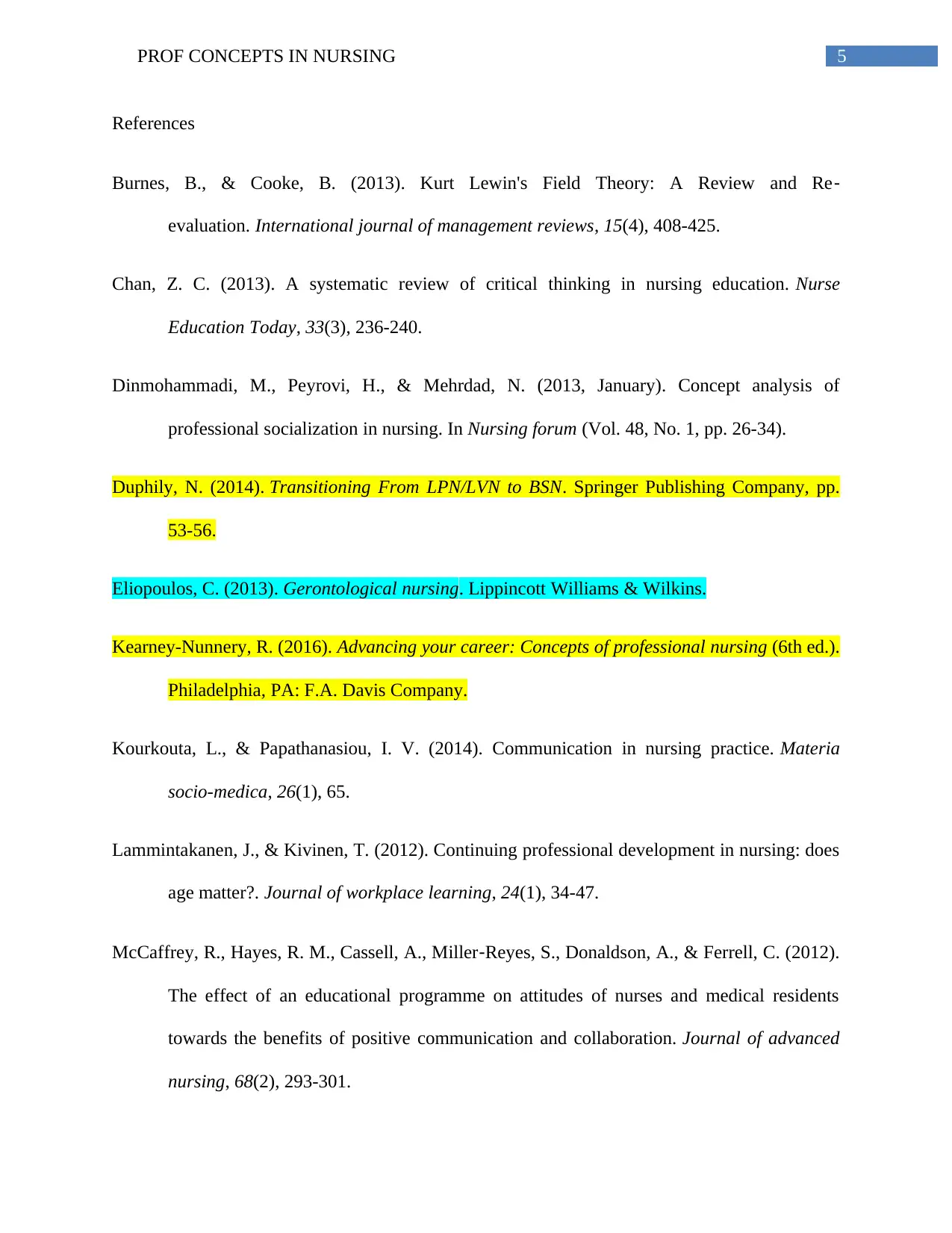
5PROF CONCEPTS IN NURSING
References
Burnes, B., & Cooke, B. (2013). Kurt Lewin's Field Theory: A Review and Re‐
evaluation. International journal of management reviews, 15(4), 408-425.
Chan, Z. C. (2013). A systematic review of critical thinking in nursing education. Nurse
Education Today, 33(3), 236-240.
Dinmohammadi, M., Peyrovi, H., & Mehrdad, N. (2013, January). Concept analysis of
professional socialization in nursing. In Nursing forum (Vol. 48, No. 1, pp. 26-34).
Duphily, N. (2014). Transitioning From LPN/LVN to BSN. Springer Publishing Company, pp.
53-56.
Eliopoulos, C. (2013). Gerontological nursing. Lippincott Williams & Wilkins.
Kearney-Nunnery, R. (2016). Advancing your career: Concepts of professional nursing (6th ed.).
Philadelphia, PA: F.A. Davis Company.
Kourkouta, L., & Papathanasiou, I. V. (2014). Communication in nursing practice. Materia
socio-medica, 26(1), 65.
Lammintakanen, J., & Kivinen, T. (2012). Continuing professional development in nursing: does
age matter?. Journal of workplace learning, 24(1), 34-47.
McCaffrey, R., Hayes, R. M., Cassell, A., Miller‐Reyes, S., Donaldson, A., & Ferrell, C. (2012).
The effect of an educational programme on attitudes of nurses and medical residents
towards the benefits of positive communication and collaboration. Journal of advanced
nursing, 68(2), 293-301.
References
Burnes, B., & Cooke, B. (2013). Kurt Lewin's Field Theory: A Review and Re‐
evaluation. International journal of management reviews, 15(4), 408-425.
Chan, Z. C. (2013). A systematic review of critical thinking in nursing education. Nurse
Education Today, 33(3), 236-240.
Dinmohammadi, M., Peyrovi, H., & Mehrdad, N. (2013, January). Concept analysis of
professional socialization in nursing. In Nursing forum (Vol. 48, No. 1, pp. 26-34).
Duphily, N. (2014). Transitioning From LPN/LVN to BSN. Springer Publishing Company, pp.
53-56.
Eliopoulos, C. (2013). Gerontological nursing. Lippincott Williams & Wilkins.
Kearney-Nunnery, R. (2016). Advancing your career: Concepts of professional nursing (6th ed.).
Philadelphia, PA: F.A. Davis Company.
Kourkouta, L., & Papathanasiou, I. V. (2014). Communication in nursing practice. Materia
socio-medica, 26(1), 65.
Lammintakanen, J., & Kivinen, T. (2012). Continuing professional development in nursing: does
age matter?. Journal of workplace learning, 24(1), 34-47.
McCaffrey, R., Hayes, R. M., Cassell, A., Miller‐Reyes, S., Donaldson, A., & Ferrell, C. (2012).
The effect of an educational programme on attitudes of nurses and medical residents
towards the benefits of positive communication and collaboration. Journal of advanced
nursing, 68(2), 293-301.
⊘ This is a preview!⊘
Do you want full access?
Subscribe today to unlock all pages.

Trusted by 1+ million students worldwide
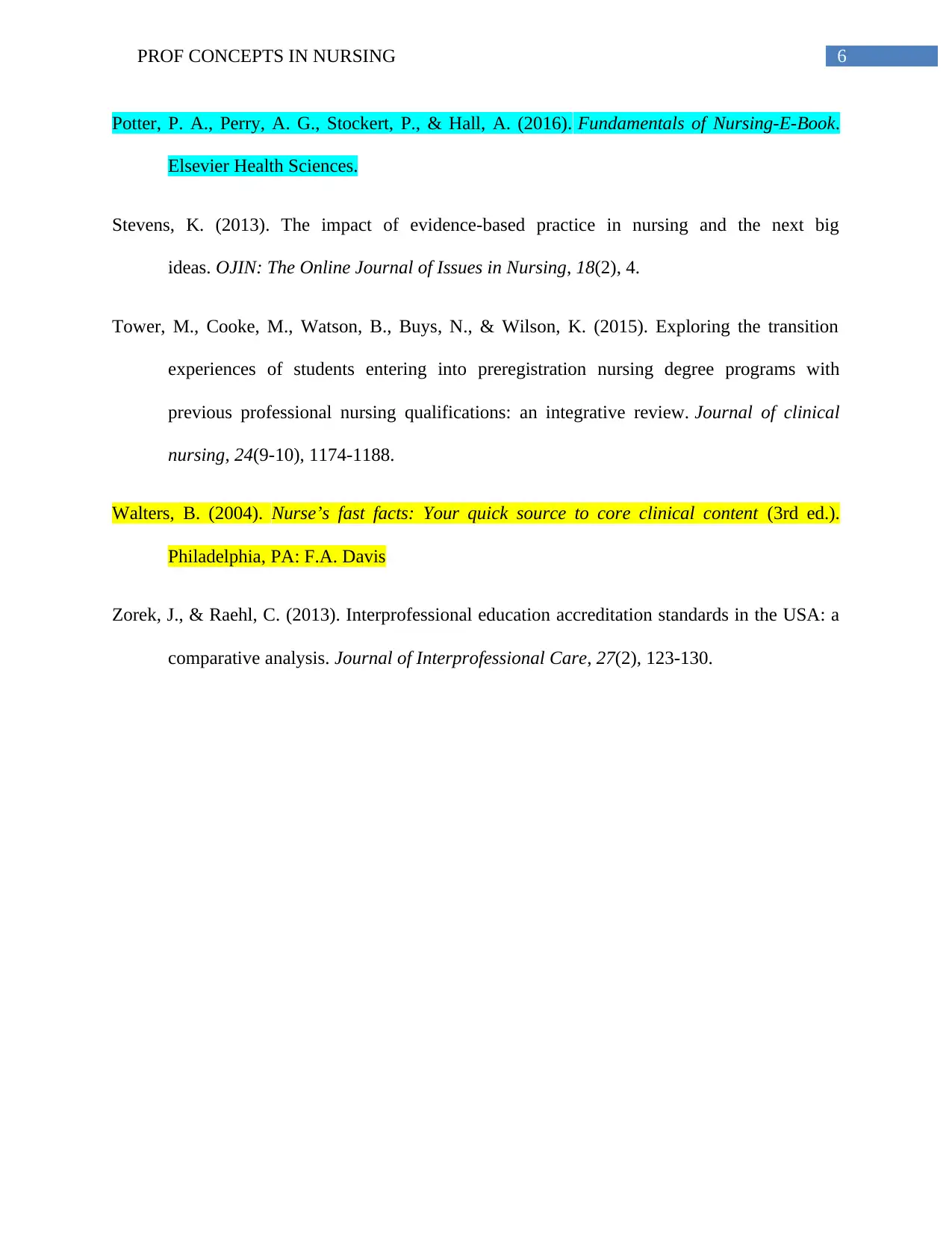
6PROF CONCEPTS IN NURSING
Potter, P. A., Perry, A. G., Stockert, P., & Hall, A. (2016). Fundamentals of Nursing-E-Book.
Elsevier Health Sciences.
Stevens, K. (2013). The impact of evidence-based practice in nursing and the next big
ideas. OJIN: The Online Journal of Issues in Nursing, 18(2), 4.
Tower, M., Cooke, M., Watson, B., Buys, N., & Wilson, K. (2015). Exploring the transition
experiences of students entering into preregistration nursing degree programs with
previous professional nursing qualifications: an integrative review. Journal of clinical
nursing, 24(9-10), 1174-1188.
Walters, B. (2004). Nurse’s fast facts: Your quick source to core clinical content (3rd ed.).
Philadelphia, PA: F.A. Davis
Zorek, J., & Raehl, C. (2013). Interprofessional education accreditation standards in the USA: a
comparative analysis. Journal of Interprofessional Care, 27(2), 123-130.
Potter, P. A., Perry, A. G., Stockert, P., & Hall, A. (2016). Fundamentals of Nursing-E-Book.
Elsevier Health Sciences.
Stevens, K. (2013). The impact of evidence-based practice in nursing and the next big
ideas. OJIN: The Online Journal of Issues in Nursing, 18(2), 4.
Tower, M., Cooke, M., Watson, B., Buys, N., & Wilson, K. (2015). Exploring the transition
experiences of students entering into preregistration nursing degree programs with
previous professional nursing qualifications: an integrative review. Journal of clinical
nursing, 24(9-10), 1174-1188.
Walters, B. (2004). Nurse’s fast facts: Your quick source to core clinical content (3rd ed.).
Philadelphia, PA: F.A. Davis
Zorek, J., & Raehl, C. (2013). Interprofessional education accreditation standards in the USA: a
comparative analysis. Journal of Interprofessional Care, 27(2), 123-130.
1 out of 7
Related Documents
Your All-in-One AI-Powered Toolkit for Academic Success.
+13062052269
info@desklib.com
Available 24*7 on WhatsApp / Email
![[object Object]](/_next/static/media/star-bottom.7253800d.svg)
Unlock your academic potential
Copyright © 2020–2025 A2Z Services. All Rights Reserved. Developed and managed by ZUCOL.





